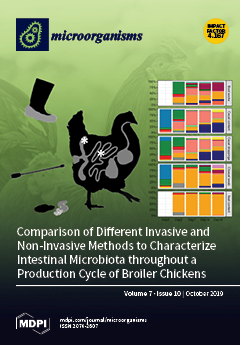Aeromonas hydrophila is a well-known bacterial pathogen associated with mass mortalities in aquaculture. Yet, few reports are available on whiteleg shrimp-pathogenic
A. hydrophila. In the present study, a virulent isolate WS05 was confirmed as a causative agent of diseased freshwater-cultured whiteleg shrimp
[...] Read more.
Aeromonas hydrophila is a well-known bacterial pathogen associated with mass mortalities in aquaculture. Yet, few reports are available on whiteleg shrimp-pathogenic
A. hydrophila. In the present study, a virulent isolate WS05 was confirmed as a causative agent of diseased freshwater-cultured whiteleg shrimp and showed a mean lethal dose (LD
50) value of 4.8 × 10
4 CFU mL
−1. It was identified phenotypically and molecularly as an
A. hydrophila strain, and exhibited susceptibility to several veterinary antibiotics extensively used in aquaculture, including cotrimoxazole, doxycycline, florfenicol, neomycin, and tetracycline. In view of the strongest inhibition zone of florfenicol against isolate WS05, the synergistic effect of the combinations of florfenicol and herb extracts was further evaluated, and the result indicated that
Punica granatum extract was a potential synergist of florfenicol against isolate WS05 and the fractional inhibitory concentration index (FICI) for the florfenicol-
P. granatum extract was calculated as 0.31. When combined with 7.81 mg mL
−1 P. granatum extract, the minimum inhibitory concentration (MIC) of florfenicol against isolate WS05 was reduced from 0.50 to 0.03 mg L
−1, and its activity against isolate WS05 was also enhanced with a significant reduction of ≥3.61 log in cell density after 24 h of treatment compared with that in the single drug treatment. In addition, the protective effect was potentiated by the combination of florfenicol and
P. granatum extract, with a cumulative mortality of 36.66% (
p < 0.05) and 33.33% (
p < 0.05) lower than that in the single treatment with florfenicol and
P. granatum extract after the challenge with isolate WS05 for seven days. As far as we know, this is the first study to describe whiteleg shrimp-pathogenic
A. hydrophila and suggest
P. granatum extract as a potential synergist of florfenicol against the
A. hydrophila pathogen.
Full article






